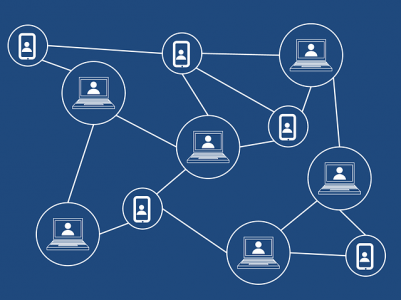Basic knowledge: The Blockchain – simply explained
More and more areas of application for block chain technology are currently being presented. And yet many people do not really know how it works. The incubator explains the basics for beginners.
Recently, there is no getting around it: the blockchain. In many places it is considered the technology of the future. More and more areas of application are appearing on the scene. But how does it actually work? Don’t worry: Despite all its complexity, its basic features are not that difficult to understand.
Note: This article does not claim to be complete. The explanations are a strong simplification of the complex matter Blockchain. The goal is to make the basic functioning of the block chain understandable for “normal consumers”. We do this by means of the best known example of use: purely digital currencies (crypto-currencies) such as Bitcoin or Ethereum.
Block chain as antithesis to the cloud
 The block chain is a network, usually within the Internet. It can also be used in an intranet. It can be seen as an antithesis to the cloud. Information is not stored somewhere on a server, but locally on all computers in the network – keyword: decentralized.
The block chain is a network, usually within the Internet. It can also be used in an intranet. It can be seen as an antithesis to the cloud. Information is not stored somewhere on a server, but locally on all computers in the network – keyword: decentralized.
This is also the reason why the technology is considered to be particularly secure: In order to falsify information, not a server would have to be hacked, but every single computer in the block chain.
Therefore, the network must reach a “critical mass” of users in order to be truly secure. After all, 50 computers could still be hacked individually. With 50,000 computers, however, the attempt seems hopeless.
Table with three columns
Very simplified one can imagine a block as an Excel table. Of course it is not, but the architecture is not dissimilar. In the case of crypto-currencies like Bitcoin, this table has three essential columns: “User A”, “User B” and “transferred amount X”. One of the users on the network now transfers a certain Bitcoin amount to another – this happens directly, from machine to machine. In the table this is now entered anonymously. The table can be found on all computers in the network. This means that all other users automatically keep track of the transaction. This confirms that the transaction has actually taken place.
The block: “Full” table is sealed
 Every transfer that is made within the network is entered in the table and it fills up line by line. As you know from Excel tables, the loading time increases with the size of the table. It cannot therefore continue indefinitely. For this reason, it is closed, sealed and stored at a certain size. A finished block is created.
Every transfer that is made within the network is entered in the table and it fills up line by line. As you know from Excel tables, the loading time increases with the size of the table. It cannot therefore continue indefinitely. For this reason, it is closed, sealed and stored at a certain size. A finished block is created.
After one block is completed and sealed, the next one is started. A chain of blocks is created – Voilá: the block chain.
Background: In Bitcoin, a block is one megabyte in size. Due to the “Segwit” (Segregated Witness) update, more space is available in the block since August 1, as this means that certain data (the signature of the transaction) is outsourced. The “lack of space” in the block had a disadvantage: it limits the number of transactions that can be carried out per second. By the way, this was also the reason for the separation of Bitcoin Cash. There they expanded to eight megabyte blocks, but did not outsource the signature of the transaction. In November, the next split occurs: With the Segwit2x update, a new coin is created that has a block size of two megabytes and at the same time outsources the signatures.
But why does the system manage with so little information stored in the block? Where is it noted who has how many Bitcoins?
Each coin is unique
The answer is once again: decentralized, on your own computer or on the server of an “online wallet” provider. While the entire network keeps records of transactions, the total amount you own is stored locally. This happens with a so-called “wallet”, i.e. a virtual purse. This is a program on your own computer, or in the case of “online wallets”, on the server of a provider. Local storage is possible because each coin or individual amount has its own unique ID. While with classic currencies the equality of each unit is central, with crypto currencies each coin is individually identifiable. Of course, the individual coins are still of equal value.
“Hardware Wallet” as protection against coin theft
- There is a weak point in the wallet on your own computer or on the individual server: While the transactions cannot be fal
 sified by the mass of users in the block chain (at least in theory), the security of the coins on the home computer or server of the provider itself must be guaranteed.
sified by the mass of users in the block chain (at least in theory), the security of the coins on the home computer or server of the provider itself must be guaranteed. - In concrete terms, there is a so-called “private key” for access – a code that must be protected.
- There are some known cases of coin theft by hackers. Local storage, however, makes it possible to “store” one’s money outside the network access – on a so-called “hardware wallet”.
- This is usually nothing more than a USB stick with special wallet software. And at the end of the day you have a physically available wallet again.
And how can the block chain be transferred to other areas?
The principle remains the same in other areas of block chain application. The actual information is stored locally. In the network, only meta-information is recorded, which secures a transaction between two users. An example would be the much-cited Smart Contracts, which run via the block chain of Ethereum, the second largest crypto currency. The content of the contract is stored on the two computers of the signing parties. In the block chain, only the “signature” of both partners is stored and thus secured.
